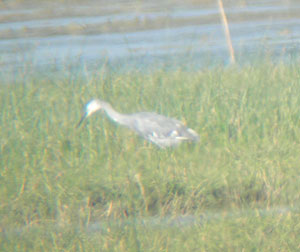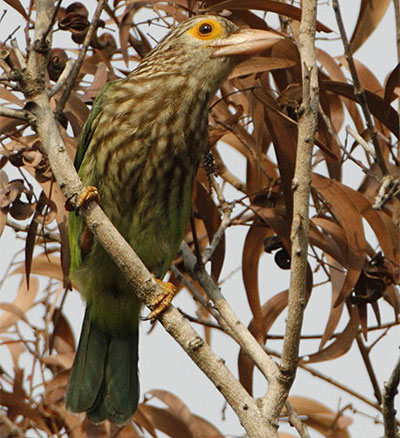The Laem Pak Bia/Pak Thale area of Petchaburi province has established itself as the best shorebird site in Thailand and one of the best in the world. What is impressive about this site is:
2. The sheer number of birds
3. The variety of species
4. The quality of species
Recently, I have been to this area 6-7 times and each time have seen 85 species plus, including a number of very rare birds and a few that are uncommon. It is not that unusual to see more than 100 species in a day.
On the 8th December I spent the day at Laem Pak Bia/Pak Thale with Des and Tina Langford from UK and we had an excellent day starting with Nordmann's Greenshank (it's good to get this bird early before work on the salt pans flushes them away) and then moving on to look for Spoon-billed Sandpiper in it regular location (also good to see this bird early for the same reasons). This bird took some time to find and it was getting tot the point where we thought we might not see it; fortunately as things were getting desperate we found 1 bird on the last pool we looked at.
The Sand Spit We hired a fishing boat to take us out to Laem Pak Bia sand spit which is a great place to find Malaysian Plover. This is a non-migratory shorebird with a restricted range; confined to sandy beaches in Southeast Asia. As sandy beaches in South East Asia suffer from development pressure from the tourist industry, this species is threatened. The boat trip takes about 30-40 minutes to get to the sand spit and Malaysian Plover is easy to find. White-faced Plover is also usually present but often requires a lot more effort to locate - we found one in a roosting flock of Greater Sand Plovers, Lesser Sand Plovers, Kentish Plovers, Curlew Sandpipers, Sanderling and Red-necked Stints.
Freshwater Wetlands The Petchaburi region has a lot of freshwater wetland areas too and a short distance from the main shorebird sites are a small area where a good number of species can be found. From the main crossroads near Hat Chao Samran one should drive back towards Petchaburi and take the first right hand turning (about 1km). This turning is for a temple and as one approaches a village there are some nice reedy areas on the right of the road. Here we found Painted Stork, Asian Openbill, Black-faced Spoonbill, Purple Heron, Pied Kingfisher, Eastern Marsh Harrier, Ruddy-breasted Crake, Oriental Reed Warbler and Greater Painted Snipe.
Also in this area was a very strange Little Egret with some sort of aberrant plumage.

Conclusion Whether you are with a guide or choose to go independently, birders will find that Laem Pak Bia/Pak Thale gives a great day's birding. Indeed, many experienced and well-traveled birders have told me that it was their best day ever! Most people visit for just 1 day but I am increasingly often spending 2 days in the area and by visiting a variety of habitats can see in excess of 130 species over the 2 days. I would suggest that more people take their time in this area and find many species that they did not expect on their Thai birding holiday.






